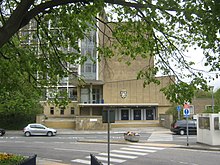Durham County Council
Durham County Council | |
|---|---|
 | |
 | |
| Type | |
| Type | |
| Leadership | |
Leader of the Council[1] | Amanda Hopgood (Liberal Democrats) |
Deputy Leader of the Council | Richard Bell (Conservatives) |
Leader of the Opposition | Carl Marshall (Labour) |
Chief Executive | John Hewitt |
| Structure | |
| Seats | 126 councillors[2] |
 | |
Political groups |
|
Length of term | 4 years |
| Elections | |
Voting system | First past the post |
Last election | 6 May 2021 |
Next election | |
| Meeting place | |
 | |
| County Hall, Durham | |
| Website | |
| www | |
Durham County Council is a local authority governing the contemporary unitary authority area of County Durham in North East England. The council area covers part of the ceremonial county of County Durham, excluding those parts which now form part of the Borough of Darlington, Borough of Hartlepool and the part of Borough of Stockton-on-Tees north of the River Tees.
Between its establishment in 1889 and major local government reforms in England in 1974, the council governed the historic county of Durham
Following the 2021 Durham County Council election the council is under no overall control. A Conservative/Liberal Democrat/Independents coalition was formed at the 2021 Annual General Meeting.[3] From 1919 to 2021 the council was under the control of the Labour Party, who held a majority except from 1922-25.
At the time of the 2011 census the council served a population of 513,200, which makes it one of the most-populous local authorities in England. It has its headquarters at County Hall in Durham.
History[]
Durham County Council was established in 1889 as the upper-tier local authority for the administrative county of Durham. At the same time Gateshead, South Shields, and Sunderland were made county boroughs, exempting them from county council control. Darlington became a county borough in 1915, Hartlepool in 1967, and Teesside in 1969. Durham was the first county council to be controlled by the Labour Party, which won the most seats in 1919.[3]
In 1974 the boundaries of the council area changed significantly as the council areas of Tyne and Wear and Cleveland were partially created from areas in the northeast and southeast of the county. At the same time the council area gained the part of Teesdale south of the River Tees from the North Riding of Yorkshire.
In 1997 Darlington became a unitary authority, removing it from county council control.
Durham County Council itself became a unitary authority on 1 April 2009, when the seven remaining districts of the county (Durham (City), Easington, Sedgefield (Borough), Teesdale, Wear Valley, Derwentside, and Chester-le-Street) were abolished and the county council absorbed their non-metropolitan district functions.
The legislation which created the unitary authority allowed the council to name itself 'The Durham Council', however 'Durham County Council' was kept.[4]
Geography[]
The district is situated around non-metropolitan areas of County Durham covering the towns of Consett, Barnard Castle, Peterlee, Seaham, Bishop Auckland, Newton Aycliffe, Middleton-in-Teesdale, Shildon, Chester-le-Street, Crook, Stanhope, Spennymoor, Ferryhill, Sedgefield and the cathedral city of Durham. As well as all surrounding hamlets, villages and suburbs of the unitary authority.[citation needed]
Darlington, Hartlepool and Stockton-on-Tees are still part of the ceremonial county of County Durham but separate from the new unitary authority.[citation needed]
References[]
- ^ "Cross party alliance to run Durham County Council as 100-year Labour rule officially ends". The Northern Echo. Retrieved 26 May 2021.
- ^ Durham County Council, webadmin@durham gov uk. "Local MPs and MEPs - information and advice". Durham County Council. Retrieved 10 February 2019.
- ^ Jump up to: a b Bloom, Dan (9 May 2021). "Labour lose control of Durham Council heartland for first time in a century". mirror. Retrieved 9 May 2021.
- ^ "The Local Government (Structural Changes) (Miscellaneous Amendments and Other Provision) Order 2009". Legislation.gov.uk. The National Archives. Retrieved 10 February 2019.
External links[]
- Billing authorities in England
- Durham, England
- English unitary authorities created in 2009
- Former county councils of England
- Leader and cabinet executives
- Local authorities in County Durham
- Local education authorities in England
- Local government in County Durham
- Unitary authority councils of England
